
Chef Graham Jefferies’ compelling, startlingly creative waste-not cooking sees his rejigged regional restaurant Samesyn 2.0 gain a second chefs’ hat.

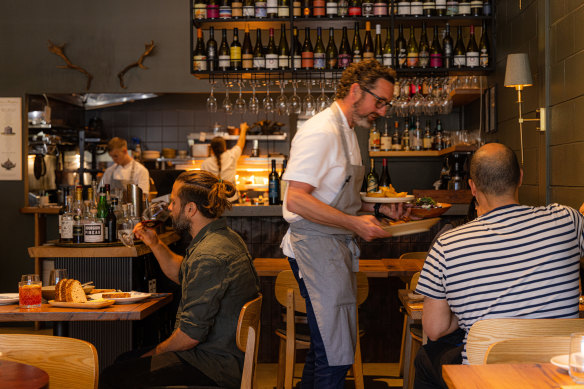
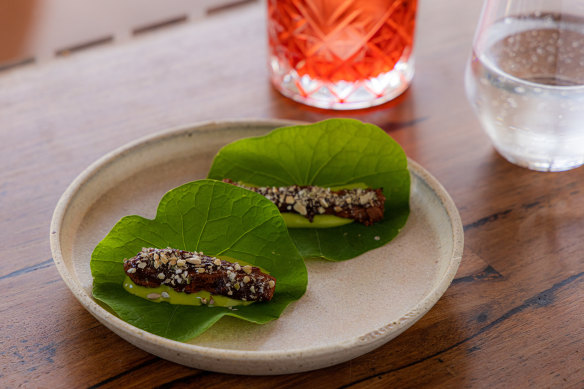
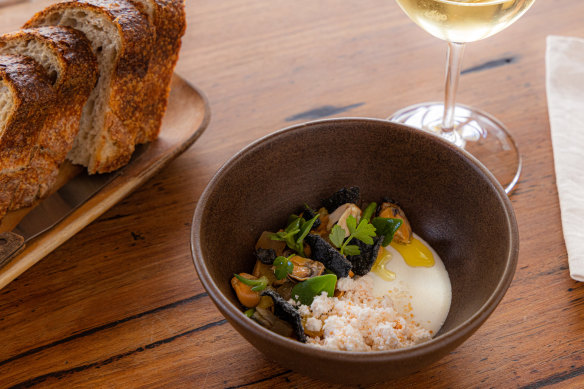
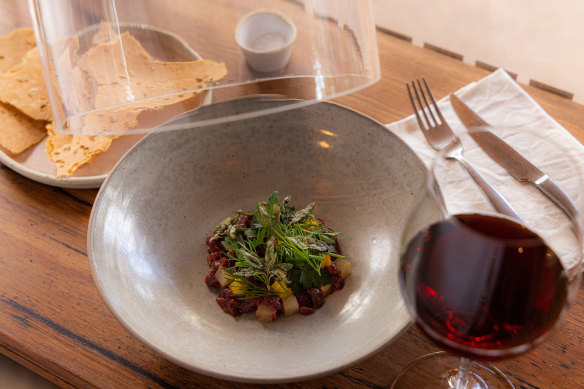
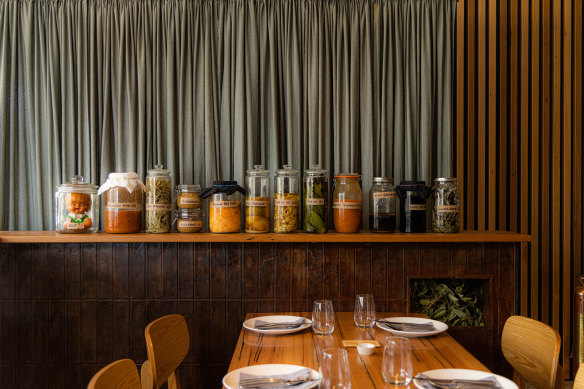
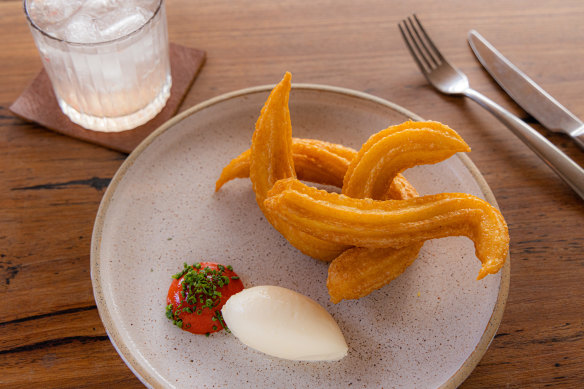
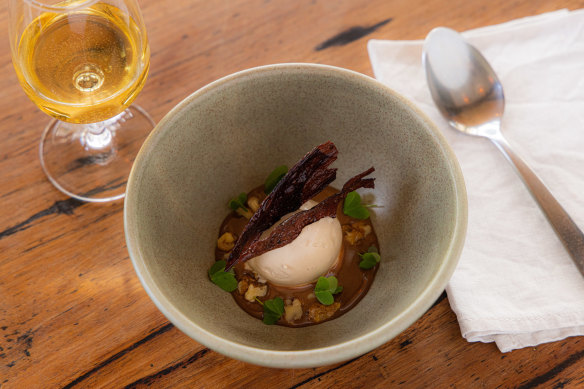
16/20
Contemporary$$
How can squidgy banana peel be a solution to a moral crisis? Samesyn shows how. Chef Graham Jefferies had been cooking for 30 years, first in South Africa, where he grew up, then in the United Kingdom and in Australia since 2005. In 2019, he opened Samesyn, a mod-Oz restaurant in Surf Coast gateway Torquay which was awarded a hat by the Good Food Guide. He was having a nice enough time cooking very lovely food for people who could afford to drop a couple of hundred bucks on dinner.
But the restaurant’s name means “togetherness” in Afrikaans and the whole project started to ring hollow once Jefferies learnt about the huge problem of food insecurity in the regions surrounding his beachy hamlet. “How can I do this,” he pondered, “while kids down the road go to bed hungry?”
He closed the business, conceived it anew over eight months and reopened in February as a profit-for-purpose entity. The restaurant now diverts its profits to Feed Me, a local charity that cooks 6000 meals a week for people doing it tough.
Samesyn 2.0 takes some of Feed Me’s cracked carrots, woody pumpkins and monstrous potatoes, all of them rejected by the retail supply chain, and uses them in the restaurant kitchen.
Jefferies might also swoop on a box of browning bananas from the Torquay fruit shop and turn them into a dessert, peel and all.
Foraged seaweed and beach herbs find their way onto the menu, and the meats include delicious steak from an old dairy cow that would otherwise be used for burger mince.

If all that wasn’t worthy enough, Samesyn is also (almost) zero waste: there’s no rubbish bin on site. Olive oil comes in refillable drums and there’s a washing machine out the back for aprons and tea towels because the laundry service only delivers in plastic bags.
It makes its own butter, air freshener and soap, the menus are on a wooden board or your phone, and any offcuts or scraps are preserved. Garlic peel is infused into oil, persimmon pulp is brewed into mead, duck trim is turned into garum, a powerful sauce.
When you’re using food that’s been diverted from landfill, it doesn’t feel right to let anything end up there.
We’ve heard plenty about how hard it is for a restaurant to make a profit but, in its first six months, Samesyn 2.0 generated $13,000 for Feed Me and saved more than a tonne of food destined for the tip.
The mission may be marvellous, but is the restaurant any good? Actually, this is one of the best meals I’ve had all year, threaded with compelling flavours and textures, startling creativity and excellent fun.
This is one of the best meals I’ve had all year, threaded with compelling flavours and textures.
The crusty sourdough bread ($10) is replenished with appetite-wrecking generosity. Oysters ($6 each) are dressed with whey (a by-product of the kitchen’s cheesemaking) and beach herbs.
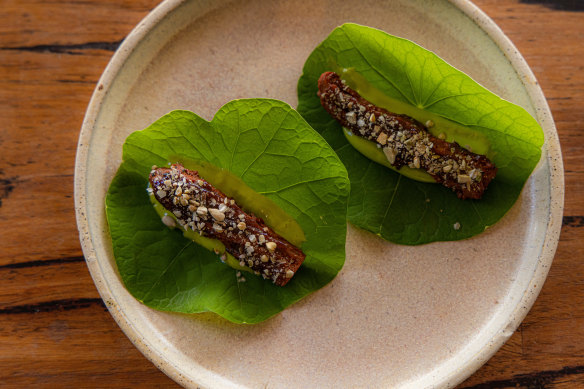
Carrots ($11) are boiled, dehydrated, then soaked in reduced carrot juice to create a toffee-like uber-carrot that has more carrot mojo per nibble than you’d think possible.
Local mussels are served with macadamia “tofu” and crackers made from fish eyes ($26), not that you’d know it.
Kangaroo tartare ($23) arrives under a smoke-filled dome; you scoop it with a crisp made from leftover bread.

Mashed potato is presented as churros ($16) and eats like a dream; swipe them through fermented capsicum puree.
And there’s that banana dessert ($10). Overripe bananas are roasted whole, then the flesh scraped and turned into ice-cream. Rather than compost the peel, it’s dried, fried and seasoned to make a sticky, bark-like garnish.
Excess milk is reduced to create dulce de leche, a naturally sweet caramel. The dish is rounded out with walnuts and brightened with wood sorrel, an easy-to-snaffle roadside herb. The nuts are the only item that cost Samesyn any money, but this reclaimed dessert is undeniably fine dining, a tasty and balanced exemplar of skill and imagination.

Samesyn glitters at the same time as being grounded: nothing drives people more than belief in what they’re doing, and there’s an earthiness and tactility aided by recycled messmate tables and the knowledge that ash from the grill is mixed with the clay used to make the crockery.
There are no waiters: chefs leave the open kitchen to ferry food. It makes sense because they’re embedded in this ecosystem, but it also trims wage costs and, therefore, boosts donations.
Just want dinner? You could come here for martinis and potato churros and not spend a moment thinking about the mission. It’ll still be one of the most meaningful meals you’ll eat all year.
The low-down
Vibe: Earnest, grounded and warm
Go-to dish: Milk jam, banana ice-cream ($10)
Drinks: Far-ranging, encompassing local beers, cocktails with foraged ingredients, quirky natural wines and benchmark bottles.
Cost: About $200 for 2 people, excluding drinks
This review was originally published in Good Weekend magazine
Restaurant reviews, news and the hottest openings served to your inbox.
Sign up








 Add Category
Add Category